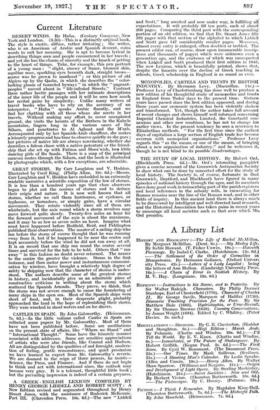GREAT STORMS. By Carr Laughton and V. Heddon. Illustrated by
Cecil King. (Philip Allan. 10s. 6d.)-Messrs. Carr Laughton and V. Heddon have embedded in an extremely readable narrative a scientific exposition of the law of storms. It is less than a hundred years ago that close observers began to plot out the courses of storms and to deduce their origin and nature. It is now well known that all storms, whether we call them hurricanes, or cyclones, or typhoons, or tornadoes, or simply gales, have a circular movement. They rotate violently since all of them are whirlwinds, but the axis round which a storm revolves may move forward quite slowly. Twenty-five miles an hour for the forward movement of the axis is about the maximum, and it may be as low as seven miles an hour. Imagine what must have happened before Redfield, Reid, and Piddington published their observations. The master of a sailing ship who ran before the storm of course thought that he was running away from it, but if he happened to be near the centre and kept accurately before the wind he did not run away at all. It is on record that one ship ran round the centre several times and survived for the tale to be told. Others that " ran away " in this fashion no doubt never returned. The nearer to the centre the greater the violence. Steam in the first instance, and then motor power and instantaneous communi- cation by wireless, have brought a relatively high degree of safety to shipping now that the character of storms is under- stood. The authors describe some of the greatest storms in history, and incidentally give us an admirable piece of constructive criticism in writing about the storm which scattered the Spanish Armada. They prove, we think, that the storm was not severe enough to cause the foundering of many ships in the open sea. Most of the Spanish ships were short of food, and, in their desperate plight, probably approached the land in the hope of replenishing their stores. They were wrecked in shoal waters and on lee shores.














































 Previous page
Previous page